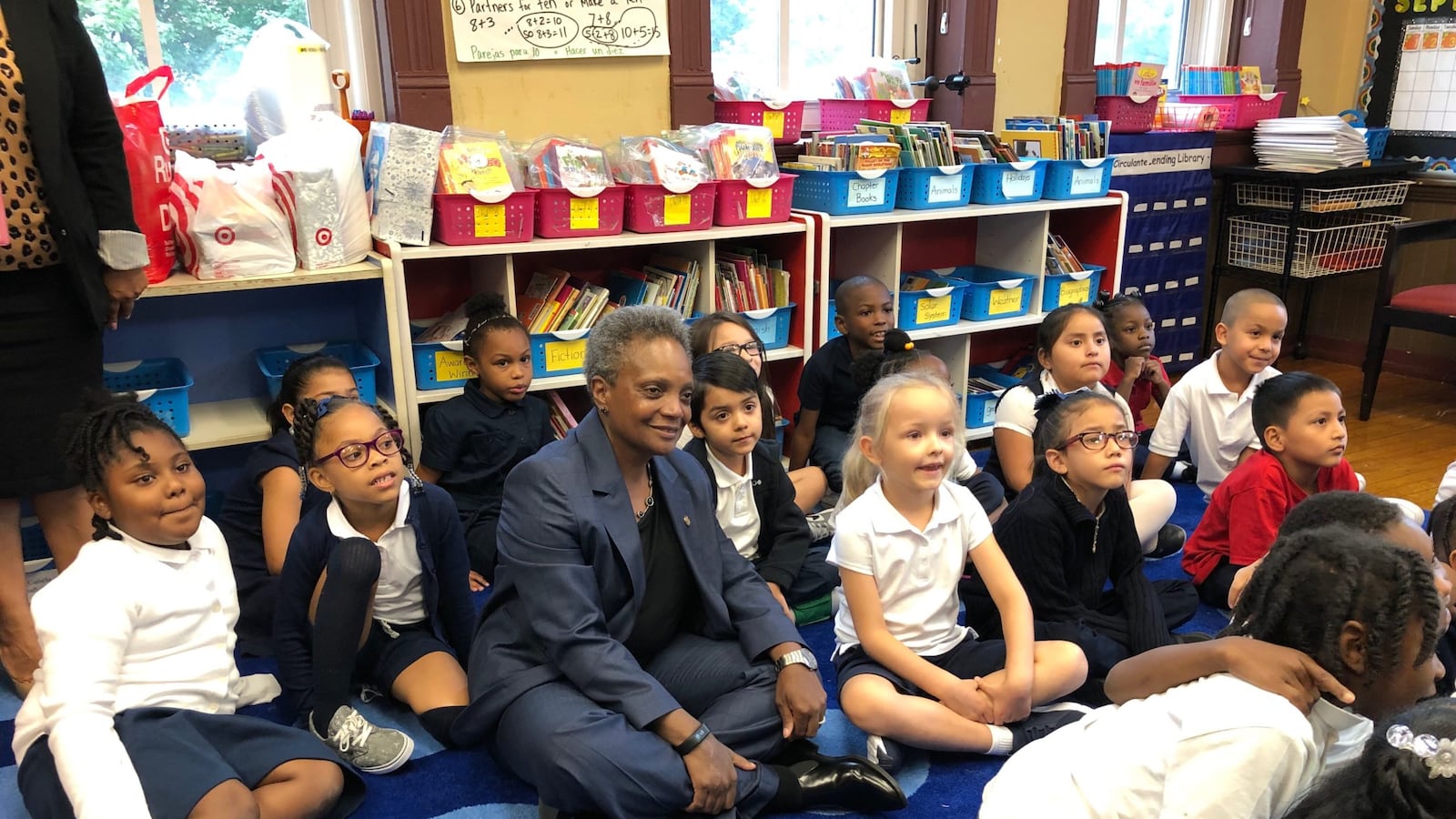This is the third story in the Lens on Lightfoot series, a collaboration of seven Chicago newsrooms examining the first year of Mayor Lori Lightfoot’s administration. Partners are Chalkbeat Chicago, the Better Government Association, Block Club Chicago, The Chicago Reporter, The Daily Line, La Raza and The TRiiBE. It is managed by the Institute for Nonprofit News.
Sullivan High School in Rogers Park has been nicknamed “Refugee High” for its student body. Often students come in speaking little English and sometimes far below grade level, while many students, both newcomers and others, suffer from the mental and emotional wounds of violence, perilous journeys, and family separation.
But with a budget that gives Sullivan roughly the same amount per student as it does for a student at Whitney Young Magnet High, a large selective-enrollment high school where fewer students live below the poverty level and parents are more involved in school fundraising, Principal Chad Adams has found himself facing what feels like an impossible choice: pay for a trauma counselor or a literacy coach, but not both.
This year, Adams chose a counselor. “I think about all the trauma my kids see,” Adams said. “Their trauma may be more impactful to their learning. But it’s a complex jigsaw puzzle.”
Schools with more students who face learning challenges, language barriers, or other difficulties need more resources to educate them. But for six years Chicago Public Schools has budgeted the same per-pupil amount for schools, regardless of students’ needs and background.

Granted, the district does give additional sums to campuses based on their count of students living in poverty or requiring special education. But the dollars often fail to cover the cost of hiring counselors and specialists.
Advocates with differing politics have assailed that budget uniformity.
As a candidate, Mayor Lori Lightfoot promised to revisit school funding and to consult the public about how to do that. Now she appears ready to fulfill her promise.
After bringing increased transparency to school board meetings and boosting staffing for high-needs schools when pressed by teachers contract negotiations, Lightfoot will start the long and complicated process of tackling one of the most technical items on her education agenda.
According to her office, by the 2021-22 school year, Chicago could shift how it hands out funds to schools. But the mayor hasn’t provided details on when, how, or who will lead the charge, which promises to be a Herculean undertaking. School officials have said an announcement is imminent. They also promised an “engagement process” related to next school year’s budget, and details on soliciting public opinion.
Related: Unlikely allies press Mayor Lori Lightfoot to reform school funding
As to whether an initiative would be led by City Hall or the school district, a city spokeswoman said in a statement that “Mayor Lightfoot and CEO [Janice] Jackson have both made it clear that promoting greater equity in our schools is a top priority, and both the City Hall and CPS teams are focused on this effort.”
How school budgets work is wonky, but they get at the heart of questions about priorities, values and investments. In a recent poll of 2,500 Chicagoans developed by a coalition of community organizations including Grassroots Collaborative and Chicago United for Equity, the second most-suggested need was to adopt a more equitable school funding formula, after increased staffing of nurses and social workers.
State funding and local property tax proceeds, along with some federal funding targeted at poor students and special education students, provide the core base for public education. The state doles out money based on some student needs, but for the most part doesn’t dictate how school districts spend the bulk of the dollars.
Chicago then distributes operating funds to the 632 district-run and charter schools it funds. This year, the total operating budget is $6.32 billion, with just over half going to individual schools.
Under a five-year-old formula, about 60% of a typical school’s district grant is based on how many students it has. In fiscal year 2020, that was an average of nearly $4,500 per student. Those funds pay for a school’s core instructional needs.
The district also pays additional sums for special education students and for programs like after-school activities. Schools also receive additional dollars for low-income students and for English language learners.
Sometimes the district will award supplemental grants. Last school year it held an application process that granted $32 million to neighborhood schools for popular academic programs, in order to help recruit more students. A similar competition has been announced for this school year.
How Chicago funds schools is in line with many other urban districts around the country, said Marguerite Roza, director of the Edunomics Lab research center at Georgetown University.
And while Roza said she understands community interest in considering different funding models, she warns that without additional funding into a new system, a new model may not make huge changes. “The district doesn’t get any more money if it moves to another budgeting model,” she said, adding that, at the same funding level, directing more money to schools with higher needs would mean less for others.
Critics say Chicago’s current way of budgeting locks schools into a downward spiral. As schools lose enrollment, they get less money, which then dooms non-core classes and extracurricular programs, which further erodes enrollment, in turn shrinking the budget even more. A September report from Roosevelt University found that the schools with the smallest budgets were concentrated in black neighborhoods that had seen precipitous population declines, contributing to racial inequality across the district.
Chicago last overhauled its funding structure in 2013, moving from a budget that allocated teacher positions at each school based on enrollment quotas, to student-based budgeting. That move gave principals more autonomy to decide how to use the per-pupil funding they received, calculated according to the number of students they had during the 20th school day of the year.
But critics said budgeting by student count doesn’t address schools’ reality.
The district has promised to consider school funding as a key part of the mayor’s five-year investment in schools, announced this summer. And the district’s new equity framework, released last month, names “resource equity” as one of its four pillars. The teachers union contract, approved in November, also includes a side letter promising the district will review school funding.
Since Lightfoot took office, a band of unlikely allies, including education reform organizations, parent groups, and the teachers union, have pressed her to overhaul school funding, to promote educational equity and bring more dollars into schools.
Some groups have been sharing ideas.
Ralph Martire from the Center for Tax and Budget Accountability, a policy research group, suggests the district scrap its current budgeting formula and instead follow the state’s “evidence-based” approach, which allocates more money to certain needy populations like homeless students, refugees, and students facing other challenging life circumstances affecting learning.
The education reform group Kids First has developed an “equity index” budgeting tool, which weighs the incidence of trauma and violence and the concentration of single-parent households in communities.
The Chicago Teachers Union has also been pushing for a more nuanced funding formula that considers student and community need. The union won a side letter in its recent contract agreement that promised the district would review school funding.
Chicagoans may get a sense of what’s on the table from the equity framework published in November by Chicago Public Schools’ year-old Office of Equity.
The framework, drafted by the district’s equity chief, Maurice Swinney, says it’s unfair to assume students from different backgrounds and facing a variety of challenges have the same needs. That will “maintain the status quo of unequal achievement,” it says, and it suggests progressive spending patterns and schools sharing resources as possible solutions.
“Tools coming soon in 2020,” the framework says.
Will Chicago redistribute current dollars or seek new funds to distribute based on student need?
That may depend on whether the district can find more dollars. During her campaign, the mayor promoted such lifelines as redistributing tax-increment financing (tax proceeds intended to finance city development projects) and boosting the district’s credit rating to secure better rates on borrowing — but in her first budget as mayor, she directed tax surplus funds only to plug spending holes in the new contract with the union. If Gov. J.B. Pritzker’s graduated income tax rate passes, it could produce more revenue and offer more financial stability for Chicago schools.
Alternately, the district could divvy up its financial pie differently — but that could drain funds from schools with fewer high-need students, a move that could set off a political firestorm at schools with more politically savvy parents, whose influence makes this option unlikely.
Effective reform requires deft political maneuvering. School funding may be an important need, but the topic is complicated and dry, even for people in the know. Lightfoot will face a challenge in both laying out the rationale and logic of a new way of budgeting and, from groups long pushing for a change, the blowback if they feel it doesn’t impact their school communities.
How the district handles budget talks with residents could affect plans.
Jianan Shi, executive director of parent group Raise Your Hand for Illinois Public Education, said, “that conversation should be centered around communities most affected: underenrolled schools, schools with a history of change, and not just a closing but any kind of school action,” such as merging campuses or redrawing attendance boundaries.
At least another full school year likely remains before a new budget system is fully in place.
At Sullivan High School, that means another year of struggling to balance the needs of a diverse student body within the school budget. Adams, the principal, is hopeful for a change.
“This is where equity could come in — you are going to have to really listen to the community needs.”
This is the third installment of the Lens on Lightfoot series. Click here to read about the first story, on aldermanic prerogative, from The Daily Line. Find the second story, a Better Government Association analysis about the mayor’s slow start on her environmental promises, here.


